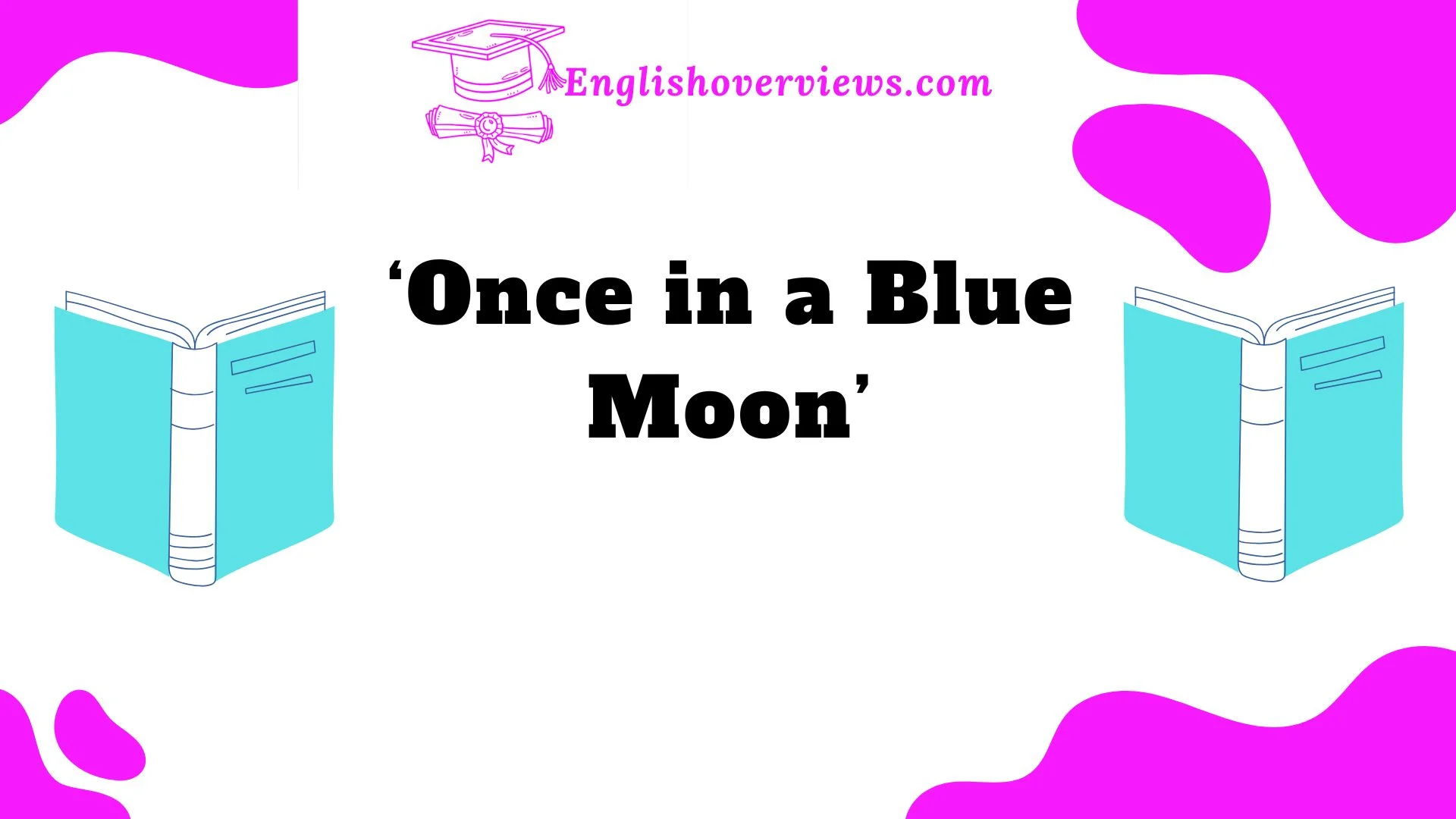Have you ever heard someone say, “That happens once in a blue moon”? It’s one of those colorful expressions that instantly paints a picture of something extraordinarily rare. But have you ever stopped to wonder where this quirky idiom comes from, what it actually means, and if it has anything to do with the moon itself?
In this article, we’ll dive deep into the historical origins, evolution, and cultural significance of the phrase. You’ll discover how literature, pop culture, and astronomy have shaped its meaning over time. We’ll also explore how the term is used in modern language, supported by real-world examples, fun facts, and misconceptions debunked along the way.
Whether you’re a language enthusiast, a curious reader, or just someone who enjoys a good trivia fact, this guide will leave you well-versed in the idiom ‘Once in a Blue Moon.’ So, let’s embark on this fascinating journey through time, culture, and the night sky.
Historical Origins of ‘Once in a Blue Moon’
Where Did the Idiom Begin?
The phrase ‘Once in a Blue Moon’ has been in use for centuries, but its exact origin is a bit hazy. The earliest documented use can be traced back to the 16th century in England. The term was first recorded in the 1528 pamphlet titled Rede Me and Be Not Wrothe, where it was used sarcastically to imply something absurdly rare or impossible.
Early Folklore and Cultural References
- In medieval England, the moon was often linked to omens and superstitions.
- The term gained traction as a metaphor for rare events that were almost mythical.
- Early farmers and sailors used lunar cycles to mark seasons, harvests, and tides, giving the moon significant cultural weight.
The Connection to the Moon Itself
Interestingly, the phrase wasn’t initially tied to an actual astronomical event. Instead, it was used metaphorically. Over time, as astronomy became more widely understood, the term began to refer to the rare phenomenon of a ‘Blue Moon.’
Key Historical Milestones:
| Year | Event | Significance |
| 1528 | First documented use in print | Used to describe absurd rarity |
| 19th century | Popular in poetry and literature | Used to describe rare events poetically |
| 20th century | Tied to astronomical events | Scientific validation added new layers of meaning |
The historical evolution of the idiom showcases how language and science often intersect to create expressions that stand the test of time.
Evolution of the Phrase Over Time
From Sarcasm to Literal Meaning
Originally, ‘Once in a Blue Moon’ was used sarcastically. It didn’t refer to the celestial event but simply something so rare it might as well be impossible.
However, by the 19th and 20th centuries, the idiom began evolving:
- 19th Century: Writers started using it metaphorically to describe improbable scenarios.
- 20th Century: With advancements in astronomy, people began connecting the term to the real astronomical phenomenon of a Blue Moon—a second full moon in a calendar month.
The Shift in Popular Usage
- By the mid-20th century, mass media and literature began using the idiom more frequently.
- Dictionaries officially added the phrase with its current definition.
How it Spread Globally
With the rise of global media, movies, and literature, the idiom spread far beyond English-speaking countries. Today, it’s a universally recognized phrase across different cultures.
Famous Literary Mentions
- “The moon was as rare as a blue moon tonight…” – A metaphorical reference from a 19th-century novel.
- Shakespearean plays often featured similar metaphors describing rarity through celestial imagery.
Takeaway:
The transformation of ‘Once in a Blue Moon’ from sarcasm to a mix of scientific fact and poetic metaphor shows how language evolves while holding onto its core meaning.
Once in a Blue Moon’ in Literature
Early Literary Mentions
The idiom first appeared in literary works as a metaphor for rarity. Writers used it to emphasize moments of profound significance or fleeting beauty.
Famous Examples in Literature:
- In Victorian poetry, writers often compared rare romantic encounters to a ‘blue moon.’
- Playwrights in the 18th and 19th centuries used the term to denote something improbable but not impossible.
Symbolism in Literature
- Blue Moon as Hope: In some stories, the phrase symbolized a glimmer of hope during difficult times.
- Blue Moon as Fate: In others, it signified events dictated by fate or destiny.
Modern Literary References
- Contemporary authors continue to use the idiom to evoke a sense of uniqueness or rarity in their storytelling.
- Example: “It was a night you’d only experience once in a blue moon, and we made the most of it.”
Table: Famous Literary Uses
| Author | Work | Usage of the Phrase |
| 19th Century Poets | Romantic Poetry | Symbol of fleeting beauty |
| Contemporary Novelists | Modern Fiction | Rare, memorable moments |
Takeaway: The idiom’s versatility allows it to shine in both classic and modern literature, adding layers of meaning to stories and poems.
The Literal Meaning vs. Idiomatic Meaning
Literal Astronomical Meaning
In astronomy, a ‘Blue Moon’ refers to:
- A second full moon in a single calendar month.
- A rare atmospheric condition where the moon appears bluish due to dust or volcanic particles.
Idiomatic Meaning
In casual conversation, ‘Once in a Blue Moon’ simply means something that happens very rarely.
Comparing Literal vs. Idiomatic Meaning:
| Aspect | Literal Meaning | Idiomatic Meaning |
| Origin | Astronomical cycles | Everyday speech |
| Frequency | Once every 2-3 years | Extremely rare events |
| Usage | Scientific context | Conversational context |
Why the Confusion?
- The rarity of both the idiom and the astronomical event creates overlap.
- People often assume the idiom originated directly from astronomy, but that’s only partially true.
Takeaway: While the literal and idiomatic meanings differ, they both highlight rarity in their own unique ways.
Conclusion
The phrase ‘Once in a Blue Moon’ has journeyed from sarcastic medieval origins to a widely recognized idiom tied to an actual astronomical event. It symbolizes rarity, uniqueness, and moments that stand out in the fabric of time. Whether used in literature, everyday conversations, or pop culture, the phrase continues to captivate and communicate a sense of something truly special.
Understanding both the historical and scientific aspects of the idiom not only enriches our appreciation of language but also connects us to the stories the moon has inspired across generations.
So, the next time you hear someone say, “That happens once in a blue moon,” you’ll know just how deep those words really go.
Frequently Asked Questions (FAQs)
1. What does ‘Once in a Blue Moon’ mean?
It refers to something that happens very rarely or almost never.
2. Is a Blue Moon a real astronomical event?
Yes! A Blue Moon is the second full moon in a single calendar month or the third full moon in a season with four full moons.
3. How often does a Blue Moon occur?
A Blue Moon occurs roughly once every 2-3 years on average.
4. Did the idiom originate from astronomy?
No, the idiom was first used metaphorically in literature and conversation long before it was tied to the actual astronomical phenomenon.
5. Can the moon actually turn blue?
Rarely, yes. The moon can appear bluish due to atmospheric conditions, like volcanic ash or smoke particles in the sky.
6. How is the phrase used in modern culture?
It’s commonly used in everyday conversation, literature, movies, and even music lyrics to describe rare events.
7. Are there other idioms that mean the same thing?
Yes! Examples include “Once in a lifetime” or “Few and far between.”
8. What are some famous examples of the phrase in pop culture?
The phrase appears in songs, movies, and literature, often symbolizing rarity or special moments.
9. Is the idiom used differently in other cultures?
While the exact phrase might not exist in all languages, similar idioms describing rare events are common worldwide.
10. When is the next Blue Moon?
The date of the next Blue Moon depends on lunar cycles. You can check astronomy calendars for upcoming dates.

Alyan Ashraf is the creative mind behind English Overviews, a platform dedicated to helping learners master the English language. Passionate about education and language development, Alyan specializes in simplifying complex English concepts, making learning accessible for students of all levels.











